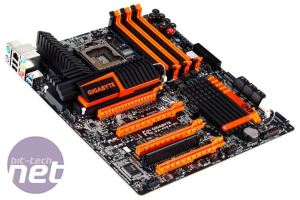
Gigabyte X58A-OC Preview
Meanwhile, Gigabyte's OC-VRM system can switch at 400, 600, 800 and 1,000kHz, and this can be adjusted on the fly. However, this is controlled via DIP switches on the PCB itself rather than via a BIOS setting, as with Asus' DIGI+ VRM system. There are pros and cons to this: the tiny DIP switches will be tough to access and change correctly when buried under insulation, but BIOS settings can only be performed in the BIOS, rather than on the fly during benchmarks.
The CPU socket also gets 20 Tantalum solid capacitors with conductive polymer (POSCAPs), which are also known as Hi-C capacitors. Gigabyte has opted to use these instead of the large Fujitsu ML caps Asus uses on its Rampage boards, but it's hard to nail down the exact benefits of each capacitor design. Both largely offer the same advantages over traditional caps: more capacity, lower ESR and high current on demand.
The extra PCI slot is still there because it's useful for debugging cards, but Gigabyte has otherwise foregone the other peripheral slots, making way for four PCI-E graphics slots, offering a choice of two 16x slots or four 8x slots. Gigabyte has opted to save some money (and latency) by not using Nvidia's NF200 hardware, but this will still enable you to set up a four-way CrossFire or 3-way SLI system.
It's also worth noting that the OC-PEG system is only there to provide extra power to your PCI-E sockets for three or four-way GPU configurations, and it won't power any of the hard drives that you hook up to the six SATA ports. This means that you won't have to fish out the Molex connectors from your PSU and try to navigate them all the way around your LN2 pots, making for a neater setup.
 The board has the standard ATX dimensions of 263.5 x 304.8mm, and the heatsinks surrounding the CPU socket and X58 chipset are designed to be easily popped off and replaced with copper pots for LN2.
The board has the standard ATX dimensions of 263.5 x 304.8mm, and the heatsinks surrounding the CPU socket and X58 chipset are designed to be easily popped off and replaced with copper pots for LN2. As usual, Gigabyte has also included its dual-BIOS system, which has saved our asses on several occasions. However, this time it also gets a BIOS switch to select the chip from which you want to boot. This means you can have one experimental BIOS, and another that always works.
Of course, Gigabyte is still playing catch-up to Asus' RoG boards in some areas. The Rampage boards have had base clock tweaking from the PCB (although not the CPU ratio) and a dual BIOS selector stick for years; you can even flash your BIOS without a CPU present. Asus' Rampage III Extreme Black will be turning up soon, and there may be more boards up Asus' sleeve to counter the X58A-OC too. However, hardware aside, overclocking often has more to do with the quality of the BIOS - how easy it is to reach those physical limits. That remains to be seen on both fronts.
Still, in both cases, unless you're pushing the bejeezus out of a Core-i7 980X or 990X, both those boards are unlikely to tempt you. That is, unless you're looking for a black and orange themed mod or a ridiculous multi-GPU setup.
Let us know your thoughts on the X58A-OC in the forums.

MSI MPG Velox 100R Chassis Review
October 14 2021 | 15:04










Want to comment? Please log in.